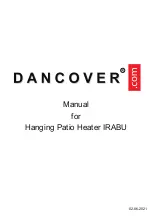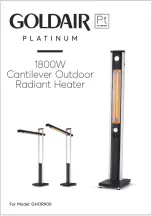
Installation instructions
Greentherm T9900 SE/i – 6 720 813 635 (2019/03)
32
4.6.7 Single Pipe Venting
NOTICE:
▶ Single pipe venting not recommended in cold climates.
▶ Installations resulting in negative pressure/back draft
require sealed combustion (twin pipe /
concentric).Damage caused from back draft, ie. freezing,
are not covered by warranty.
NOTICE:
▶ When installed in an environment where corrosive
chemicals or dirty air (e.g. hair salons, car washes) are
present the sealed combustion (twin pipe or concentric) is
required.
Air combustion
WARNING:
The lack of adequate air openings may lead to improper
operation of other appliances consuming air.
▶ Always follow local codes and regulations of authority
having jurisdiction in case of single pipe installation in
confined spaces.
Although it is permissible to draw the air-intake from the inside,
it is not the manufacturer’s recommended installation method.
Install a 90° elbow or air intake screen on the top of the air-
intake inlet adaptor to prevent foreign objects from falling into
the unit.
If a single pipe installation is utilized, follow guidelines below for
providing adequate combustion air for the water heater as well
as any other appliances that may consume air in the same
space. Always follow local codes and regulations of the
authority having jurisdiction.
•
Appliances located in unconfined spaces:
–
a)
An unconfined space is one whose volume is greater
than 50 cubic feet (1.42 cubic meter) per 1000 BTU/
hr (292.81 Watts) of the combined rating of all
appliances installed in the space. That would be 9950
cubic feet (281.8 cubic meters) or 1243 square feet
with 8 foot ceiling, for a single 199 kBTU water heater.
–
b)
In unconfined spaces in buildings of conventional
frame, masonry, or metal construction, infiltration air is
normally adequate to provide air for combustion.
•
Appliances located in confined spaces:
The confined space must be provided with two permanent
openings, one commencing within 12 inches (304.8mm)
of the top and one commencing within 12 inches
(304.8mm) of the bottom of the enclosure. Each opening
must have a minimum free area of one square inch per:
– 1000 BTU/hr (292.81 Watts) if all air is taken from
inside the building
– 2000 BTU/hr (585.62 Watts) if all air is taken from the
outside by horizontal ducts
– 4000 BTU/hr (1171.24 Watts) if all air is taken from
the outside by direct openings or vertical ducts
Or the confined space must be provided with one permanent
opening or duct that is within 12 inches (304.8mm) of the
ceiling of the enclosure. This opening must have a minimum
free area of one square inch per:
– 3000 BTU/hr (878.43 Watts) if all air is taken from the
outside by a direct opening or vertical duct.
Louvers, grills and screens have a blocking effect, when used,
increase the sizes of your openings by 300% for wood louvers
(as wood type will reduce the free air by 75%) and 43% for
metal louvers (as metal will reduce the free air by 30%). Refer
to the National Fuel Gas Code for complete information.
4.7
Factory regulation
The appliances are supplied having been set in the factory for
the values shown on the rating plate for natural gas.
For any other adjustments see chapter 7.
4.7.1 Natural gas
The appliances must not be operated if the dynamic gas
pressure is less than 3.5” WC
1)
or greater than 10.5” WC.
4.7.2 Liquid propane gas (after gas conversion)
The appliances must not be operated if the dynamic gas
pressure is less than 8”WC or greater than 13” WC.
If gas conversion is needed (
Natural Gas to Liquid propane
gas
1) To assure maximum heat input at maximum vent length
minimum gas pressure should be 5" W.C. for the 199 kBTU
models and 4" W.C. for the 160 kBTU models. For more
information see section 4.6.3.
















































